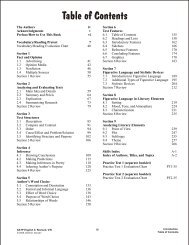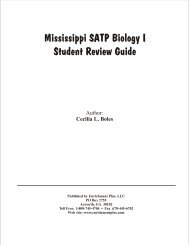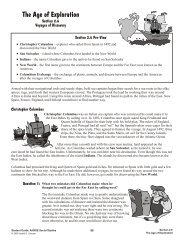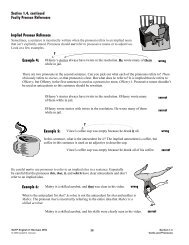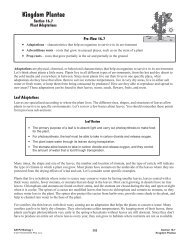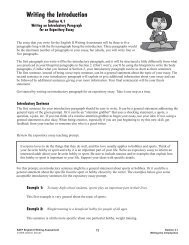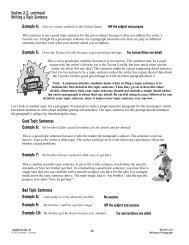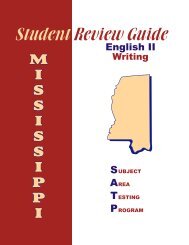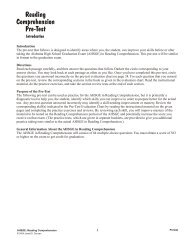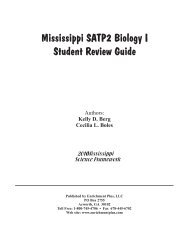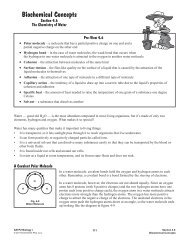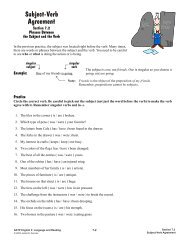Writing/Grammar Pre-Test - Enrichment Plus
Writing/Grammar Pre-Test - Enrichment Plus
Writing/Grammar Pre-Test - Enrichment Plus
You also want an ePaper? Increase the reach of your titles
YUMPU automatically turns print PDFs into web optimized ePapers that Google loves.
Verbals<br />
Section 7.6<br />
Sentence Combining<br />
<strong>Pre</strong>-View 7.6<br />
! Correlative conjunctions – conjunctions, such as either . . . or, neither . . . nor, not only . . . but also,<br />
both . . . and<br />
! Parallel – having the same grammatical structure<br />
Combining the ideas from two different statements into one sentence can be an effective writing strategy. You’ve<br />
already seen how to combine statements with both equal and unequal emphasis (in Sections 5 and 6). Now let’s look<br />
more closely at combining statements with equal emphasis by using correlative conjunctions that join verbals or<br />
long prepositional phrases. These types of sentences are usually longer and look a little “messier,” but you have<br />
already practiced the basics. Just remember that when you combine two sentences with verbals or prepositional<br />
phrases, the parts must be parallel (grammatically equal).<br />
Example:<br />
Combine the following two statements into one sentence by giving each equal emphasis.<br />
Statement 1: Hikers traveling to the bottom of the Grand Canyon cannot afford to become<br />
dehydrated.<br />
Statement 2: They also cannot allow their blood sugar to drop.<br />
A good way to combine these statements is to use the correlative conjunctions neither . . . nor. But when<br />
using correlative conjunctions, be careful to make both parts parallel.<br />
Hikers traveling to the bottom of the Grand Canyon can afford neither to<br />
become dehydrated nor to allow their blood sugar to drop.<br />
parallel<br />
Notice that neither to become . . . and nor to allow . . . are parallel because to become and to allow both start<br />
infinitive phrases.<br />
Hint: In many cases, you can look at only the first one or two words after each correlative<br />
conjunction to determine parallelism. First, identify the correlative conjunctions. Then look<br />
at only the first one or two words after them. Ignore the rest of the words.<br />
Hikers traveling to the bottom of the Grand Canyon can afford neither to<br />
become dehydrated nor by allowing their blood sugar to drop.<br />
NOT parallel<br />
Now notice that neither to become . . . and nor by allowing . . . are NOT parallel. To become starts an<br />
infinitive phrase and by allowing starts a prepositional phrase.<br />
Although hikers traveling to the bottom of the Grand Canyon cannot afford<br />
to become dehydrated, they also cannot allow their blood sugar to drop.<br />
NOT equal<br />
There is nothing grammatically wrong with this sentence, but since it is a complex sentence that uses a<br />
subordinate conjunction (although), it does not give both statements equal emphasis. Instead, it gives more<br />
emphasis to the second statement.<br />
SATP2 English II: W/G<br />
© 2012 <strong>Enrichment</strong> <strong>Plus</strong>, LLC<br />
139<br />
Section 7.6<br />
Verbals



